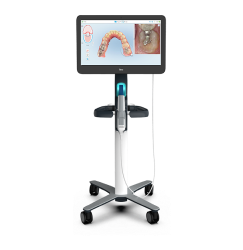Orthodontic treatment has come a long way from the days of one-size-fits-all braces. Today, artificial intelligence (AI) is transforming orthodontics, allowing for more precise, efficient, and personalized treatment plans. Whether it’s predicting tooth movement, customizing aligners, or improving patient outcomes, AI is making orthodontic care smarter than ever.
At Robert Stoner Orthodontics, we embrace cutting-edge technology to provide our patients with the best possible care. Here’s how AI is shaping the future of orthodontics and what it means for you.
How AI Is Changing Orthodontic Treatment
AI-powered orthodontics relies on advanced algorithms, machine learning, and digital imaging to create customized treatment plans for each patient. Here are the key ways AI is revolutionizing orthodontic care:
1. AI-Powered 3D Imaging and Scanning
Gone are the days of messy molds and uncomfortable impressions. AI-driven 3D scanning technology allows orthodontists to:
- Capture high-resolution images of teeth and jaw structures
- Create a precise digital model of the patient’s mouth
- Use AI to analyze tooth movement and predict changes over time
This technology enables orthodontists to design treatment plans with extreme accuracy, reducing errors and improving efficiency.
2. Personalized Treatment Plans with AI Algorithms
AI can analyze a patient’s dental structure, bite alignment, and tooth movement patterns to generate a treatment plan that is fully customized to their needs.
- For Braces: AI helps orthodontists determine the optimal bracket placement and wire adjustments for faster, more efficient treatment.
- For Invisalign: AI predicts how teeth will shift over time, creating a series of aligners that move teeth with minimal discomfort.
Because AI can simulate treatment progress, patients can see a visual preview of their final smile before treatment even begins.
3. Faster and More Efficient Orthodontic Treatment
Traditional orthodontic treatments often require frequent adjustments and manual fine-tuning. With AI, orthodontists can:
- Reduce the number of in-office visits by optimizing adjustments ahead of time
- Use predictive models to shorten treatment times by ensuring teeth move in the most efficient way
- Track progress remotely, allowing for virtual check-ins and AI-powered monitoring
This means fewer trips to the office and a smoother, more predictable orthodontic experience.
4. AI-Powered Remote Monitoring
One of the biggest advancements in orthodontics is AI-driven remote monitoring, which allows patients to track their progress from home using their smartphone.
- Patients take photos or scans of their teeth using a specialized app.
- AI analyzes the images and detects any issues or delays in treatment.
- Orthodontists receive real-time updates and can make adjustments without requiring an in-office visit.
This technology is especially beneficial for Invisalign patients, who can stay on track without constant in-person checkups.
5. Improved Accuracy and Predictability
AI removes much of the guesswork from orthodontic treatment. In the past, orthodontists relied on experience and manual calculations to estimate how teeth would move. Today, AI can:
- Analyze thousands of cases to predict the best possible outcome
- Detect potential complications early, allowing for proactive adjustments
- Ensure teeth move efficiently and safely, reducing overall treatment time
With AI, patients get more precise results with fewer unexpected changes.
What AI Means for Patients: A Better Orthodontic Experience
For patients, the integration of AI into orthodontics means:
- Faster treatment times – AI optimizes tooth movement, reducing the time spent in braces or aligners.
- Fewer office visits – Remote monitoring allows for fewer in-person appointments.
- More comfortable treatments – AI predicts and minimizes discomfort by adjusting treatment plans accordingly.
- Highly personalized care – Each treatment plan is tailored to the patient’s unique dental structure and needs.
At Robert Stoner Orthodontics, we use the latest AI-driven technology to ensure faster, smarter, and more effective orthodontic treatment.
The Future of AI in Orthodontics
AI is still evolving, but its role in orthodontics is growing rapidly. In the future, we can expect:
- Even more precise 3D-printed aligners tailored for individualized tooth movement.
- Real-time AI feedback during treatment, ensuring maximum efficiency.
- AI-powered robotic orthodontics, which may further streamline adjustments.
As technology advances, orthodontic treatment will become even more convenient, efficient, and personalized.
If you’re considering braces or Invisalign, now is the perfect time to take advantage of AI-powered orthodontics. At Robert Stoner Orthodontics, we use the latest advancements in digital scanning, predictive modeling, and remote monitoring to give you a faster, more comfortable orthodontic experience.
